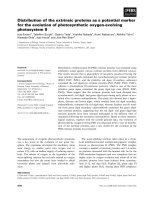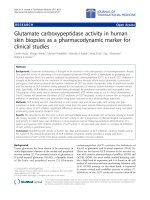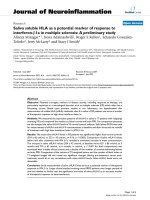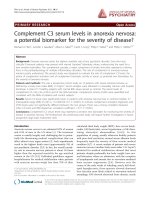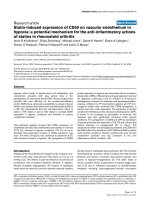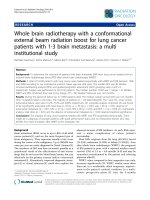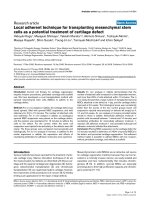Serum albumin level as a potential marker for deciding chemotherapy or best supportive care in elderly, advanced nonsmall cell lung cancer patients with poor performance status
Bạn đang xem bản rút gọn của tài liệu. Xem và tải ngay bản đầy đủ của tài liệu tại đây (704.7 KB, 8 trang )
Ikeda et al. BMC Cancer (2017) 17:797
DOI 10.1186/s12885-017-3814-3
RESEARCH ARTICLE
Open Access
Serum albumin level as a potential marker
for deciding chemotherapy or best
supportive care in elderly, advanced nonsmall cell lung cancer patients with poor
performance status
Satoshi Ikeda1,2* , Hiroshige Yoshioka1, Satoshi Ikeo1, Mitsunori Morita1, Naoyuki Sone1, Takashi Niwa2,
Akihiro Nishiyama1, Toshihide Yokoyama1, Akimasa Sekine2, Takashi Ogura2 and Tadashi Ishida1
Abstract
Background: There have been few data on the chemotherapy in elderly advanced non-small cell lung cancer
(NSCLC) patients with poor performance status (PS), and usefulness of chemotherapy for such patients remains
unclear. The objective of this study was to identify factors that predicted the survival benefit of chemotherapy.
Methods: All consecutive elderly patients (≥75 years) with advanced NSCLC, Eastern Cooperative Oncology Group
PS ≥2, EGFR mutation wild type/unknown, and newly diagnosed from January 2009 to December 2012 at a tertiary
hospital were retrospectively reviewed.
Results: We enrolled 59 patients, and 31 patients received at least one chemotherapy regimen (chemotherapy group).
However, 28 patients received best supportive care (BSC) alone (BSC group). The proportion of PS 2 and serum
albumin levels was significantly higher in the chemotherapy group than in the BSC group. In the chemotherapy group,
log-rank testing did not show statistically significant differences in overall survival (OS) between the single-agent
therapy group and carboplatin-based doublet therapy group; however, the OS of patients receiving chemotherapy for
only 1 cycle (early termination) was significantly shorter than patients receiving chemotherapy for ≥2 cycles.
Hypoalbuminemia was not only a risk factor for the early termination of chemotherapy but also an independent
prognostic factor in the chemotherapy group. A receiver operating characteristic curve analysis showed that the best
cut-off value was 3.40 g/dL. In patients with serum albumin levels ≥3.40 g/dL, OS was significantly better in the
chemotherapy group than in the BSC group (p = 0.0156), however, patients with serum albumin levels <3.40 g/dL
exhibited poor prognosis regardless of the presence or absence of chemotherapy.
Conclusion: In the elderly NSCLC patients with poor PS, serum albumin levels may help identify certain patient
populations more likely to receive a survival benefit of systemic chemotherapy.
Keywords: Non-small cell lung cancer, Elderly, Performance status, Albumin, Hypoalbuminemia
* Correspondence:
1
Department of Respiratory Medicine, Kurashiki Central Hospital, Miwa 1-1-1,
Kurashiki-city 710-8602, Japan
2
Department of Respiratory Medicine, Kanagawa Cardiovascular and
Respiratory Center, Tomioka-Higashi 6-16-1, Kanazawa-ku, Yokohama-city
236-0051, Japan
© The Author(s). 2017 Open Access This article is distributed under the terms of the Creative Commons Attribution 4.0
International License ( which permits unrestricted use, distribution, and
reproduction in any medium, provided you give appropriate credit to the original author(s) and the source, provide a link to
the Creative Commons license, and indicate if changes were made. The Creative Commons Public Domain Dedication waiver
( applies to the data made available in this article, unless otherwise stated.
Ikeda et al. BMC Cancer (2017) 17:797
Background
Among patients newly diagnosed with non-small cell lung
cancer (NSCLC) in developed countries, approximately
50% are ≥70 years at the time of diagnosis [1], and 30%–
40% are with an Eastern Cooperative Oncology Group
(ECOG) performance status (PS) ≥ 2 [2]. Because older
age and poor PS have often been related to the increased
risk of toxicity associated with cytotoxic chemotherapy,
such patients have often been excluded from clinical trials. To note, some randomized phase 3 trials of singleagent therapy have been conducted for elderly, advanced
NSCLC patients. In the Elderly Lung Cancer Vinorelbine
Italian Study (ELVIS), median overall survival (OS) was
significantly better in the vinorelbine group than that in
the best supportive care (BSC) group [3, 4]. The Multicenter Italian Lung Cancer in the Elderly Study (MILES)
revealed that median OS in the gemcitabine group was almost equal to that in the vinorelbine group [5]. Subsequently, the WJTOG9904 trial [6] showed that patients
treated with docetaxel had a significantly higher response
rate and better progression-free survival (PFS) compared
with patients taking vinorelbine. However, the difference
in OS was not statistically significant, and severe neutropenia was more common with docetaxel. In addition, trials of platinum-based doublet therapy have also been
conducted in elderly patients. In a French Intergroup
Study (IFCT-0501), OS was significantly betterin the carboplatin plus weekly paclitaxel group than that in the
single-agent therapy (gemcitabine or vinorelbine) group
[7]. However, grade ≥ 3 neutropenia and treatmentrelated death was more common with carboplatin plus
weekly paclitaxel compared with single-agent therapy.
Based on these trial results, single-agent therapy (docetaxel, gemcitabine, or vinorelbine) was recommended as
first-line treatment for elderly, advanced NSCLC patients
without known driver mutations, and carboplatin-based
doublet therapy may be a viable option in patients
deemed able to tolerate such therapy. However, little is
known concerning chemotherapy in elderly, advanced
NSCLC patients with poor PS, and the usefulness of
chemotherapy for such patients remains unclear. Moreover, elderly patients who are enrolled in clinical trials
represent a carefully selected subset. In clinical practice,
elderly patients are a more heterogeneous population,
with baseline organ dysfunctions and variable comorbidities, and the PS alone is not sufficient enough to account
for the heterogeneity within elderly patients. It is critically
important to identify patient populations that can receive
a survival benefit of systemic chemotherapy in elderly patients with poor PS. In the present study, we retrospectively reviewed consecutive elderly patients (≥75 years of
age) with advanced NSCLC and with poor PS (ECOG
PS ≥ 2) to identify factors that predict the survival benefit
of cytotoxic chemotherapy.
Page 2 of 8
Methods
Patients and settings
All consecutive patients enrolled were (1) pathologically or
cytologically confirmed NSCLC; (2) at stage IIIB or IV according to the 7th edition TNM classification; (3) ≥75 years
of age; (4) with an Eastern Cooperative Oncology Group
(ECOG) performance status (PS) ≥ 2; (5) with an epidermal
growth factor receptor mutation wild type or unknown
status; and (6) newly diagnosed at the Kurashiki Central
Hospital (Kurashiki city, Okayama, Japan) from January
2009 to December 2012. The exclusion criteria included
clinical diagnosis of lung cancer without pathological or
cytological confirmation. In patients with ECOG PS ≥ 3,
chemotherapy could be carried out only when the patient
was diagnosed as treatable and tolerable for chemotherapy
by the attending physician, and the patient and family were
strongly hoping for the chemotherapy, even though
they knew all the risks. This study has been carried out
in accordance with the Declaration of Helsinki. The
Ethics Committee of the Kurashiki Central Hospital
approved the study protocol, and patient consent was
waived because this was a retrospective study and anonymity was secured.
Clinical and laboratory findings
Clinical and laboratory data used in this study were retrieved from patient medical records and included age;
gender; the ECOG PS; smoking status; comorbidities;
tumor histology; cancer stage; major diameter of the primary site; metastatic organs (brain, bone, liver, and adrenal gland); laboratory data such as white blood cell,
neutrophil, and lymphocyte counts as well as hemoglobin,
albumin, lactate dehydrogenase, serum calcium, and Creactive protein levels; treatment status; progression free
survival (PFS) of initial treatment; and OS. The OS was
defined as the length of time from the date of diagnosis to
death of any cause.
Statistical analysis
Categorical data are presented as numbers (percentages),
whereas continuous data are presented as medians
(interquartile ranges). Fisher’s exact test was used to
compare categorical data, and the Mann–Whitney U test
was used to compare continuous data. Cumulative survival probabilities were estimated using the KaplanMeier method. The log-rank test was used to compare
survival among patient groups. A multivariate analysis
using a Cox proportional hazard model was performed
to identify the factors associated with survival. A multivariate logistic regression analysis was performed to verify the risk factor for a categorical dependent variable.
The factors with p-values <0.05 in univariate analysis
were selected as candidate factors of multivariate analysis. A receiver operating characteristic (ROC) curve
Ikeda et al. BMC Cancer (2017) 17:797
Page 3 of 8
analysis was used to determine the optimal cut-off
values for the risk factor; values with maximum joint
sensitivity and specificity were selected. A p-value of
<0.05 was considered statistically significant.
better in the chemotherapy group than in the BSC group
(median OS of 4.7 months and 3.1 months, p = 0.0119).
Results
Treatment details in the chemotherapy group are shown in
Table 2. Twenty of the 31 patients (64.5%) received singleagent therapy, whereas 11 of the 31 patients (35.5%) received carboplatin-based doublet therapy. Patients who
received carboplatin-based doublet therapy had higher response rates, and the median PFS values were better. No
significant differences were observed in the disease control
rate and median number of treatment cycles. An adverse
event was the most common cause of cessation in patients
receiving single-agent therapy, whereas, in patients receiving
carboplatin-based doublet therapy, completion of 4–6
courses was the most common, followed by an adverse
event. With regard to OS, log-rank testing did not show
Baseline characteristics and prognoses in the study
population
In the present study, 59 patients were enrolled. Thirtyone patients received at least one chemotherapy regimen
(chemotherapy group), whereas 28 patients received best
supportive care (BSC) alone (BSC group). Patients’ characteristics are summarized in Table 1. The proportion of
PS 2, lymphocyte count, and serum albumin level were
significantly higher in the chemotherapy group than in
the BSC group. No significant differences were observed
regarding other clinical and laboratory data. A comparison of survival curves is shown in Fig. 1. The OS was
Treatment details and prognosis in the chemotherapy
group
Table 1 Baseline characteristics of the study population
Chemotherapy (N = 31)
Best supportive care (N = 28)
p-value
Age
78.0 [76.5–80.0]
80.5 [77.0–84.3]
0.118
Gender (male/female)
4 / 27
4 / 24
1.00
ECOG Performance Status (2/3/4)
18/12/1
8/15/5
0.0350
Smoking history
30 (96.8%)
22 (78.6%)
0.0870
Brinkman Index
1100 [780–1550]
800 [420–1395]
0.113
26 (83.9%)
20 (71.4%)
0.348
Interstitial pneumonia (%)
1 (3.2%)
1 (3.6%)
1.00
Diabetes mellitus (%)
13 (41.9%)
1 (3.6%)
0.00100
Comorbidities
Emphysema (%)
Histology (Non-Squamous/Squamous)
6 / 25
6 / 22
1.00
Staging (IIB/IV)
5 / 26
2 / 26
0.428
Major diameter of the primary site
39.5 [27.5–65.0]
52.0 [40.5–74.0]
0.0740
Metastatic organ
Brain (%)
6 (19.4%)
4 (14.3%)
0.734
Bone (%)
10 (32.3%)
6 (21.4%)
0.393
Liver (%)
3 (9.7%)
3 (10.7%)
1.00
Adrenal gland (%)
4 (12.9%)
1 (3.6%)
0.356
White blood cell count
7800 [6450–9700]
7700 [6175–11,925]
0.802
Neutrophil count
5336 [4502–6684]
5988 [4513–8929]
0.362
Lymphocyte count
1396 [1148–1721]
1086 [848–1432]
0.0370
Hemoglobin
12.4 [11.0–14.0]
12.0 [11.5–13.2]
0.885
Albumin
3.60 [3.20–3.95]
3.30 [2.85–3.62]
0.0460
Lactate dehydrogenase
214 [188–247]
247 [206–277]
0.141
Calcium
9.20 [9.00–9.55]
9.00 [8.47–9.33]
0.093
C-reactive protein
1.81 [0.66–3.92]
3.20 [0.57–7.59]
0.391
Laboratory data
Categorical data are presented as numbers (percentages) whereas continuous data are presented as medians (interquartile ranges). Fisher’s exact test was used to
compare categorical data, and the Mann–Whitney U test was used to compare continuous data
Abbreviations: ECOG Eastern Cooperative Oncology Group
Ikeda et al. BMC Cancer (2017) 17:797
Page 4 of 8
statistically significant differences between the single-agent
therapy and carboplatin-based doublet therapy groups (median OS of 3.80 months and 7.00 months, p = 0.773)
(Fig. 2a). On the other hand, the OS of patients receiving
chemotherapy for only 1 cycle was significantly shorter than
patients receiving chemotherapy for ≥2 cycles (median OS
of 3.0 months and 11.6 months, p = 0.0000241) (Fig. 2b).
Risk factors for the early termination of chemotherapy
Fig. 1 A comparison of survival curves between chemotherapy and BSC
groups. A comparison of survival curves is shown. The overall survival
(OS) was better in the chemotherapy group than in the BSC group
Table 2 Treatment details and prognoses of first-line chemotherapy
Single-agent
(N = 20)
Platinum doublet
(N = 11)
Gemcitabine
8 (40.0%)
0
Vinorelbine
6 (30.0%)
0
Docetaxel
5 (25.0%)
0
Pemetrexed
1 (5.0%)
0
Carboplatin + weekly paclitaxel
0
9 (81.8%)
Carboplatin + gemcitabine
0
1 (9.1%)
Carboplatin + S-1
Regimen
0
1 (9.1%)
Response rate (%)
0
45.4%
Disease control rate (%)
55.0%
54.5%
Progression free survival (month)
2.87
[0.60–7.27]
5.43
[1.58–8.07]
Number of treatment cycles
2.00
[1.00–2.25]
3.00
[1.00–4.00]
Early termination (only 1 cycle) (%)
7 (35.0%)
4 (36.4%)
Adverse event
11 (55.0%)
4 (36.4%)
Deterioration of physical condition
5 (25.0%)
0
Completion of 4–6 cycles
0
5 (45.5%)
Progressive disease
3 (15.0%)
1 (9.1%)
Patient’s request
1 (5.0%)
1 (9.1%)
Cause of cessation
Categorical data are presented as numbers (percentages) whereas continuous
data are presented as medians (interquartile ranges)
Eleven patients received chemotherapy for only 1 cycle
(early termination group), whereas 20 patients received
chemotherapy for ≥2 cycles (continuous treatment group).
When comparing the clinical and laboratory data between
two groups (Additional file 1 Table S1), the incidence of
bone metastasis was higher and serum albumin levels
were lower in the early termination group than in the continuous treatment group. No significant differences were
observed for any other clinical and laboratory data.
A logistic regression analysis was performed to verify
the risk factor for the early termination of chemotherapy
(Table 3). In univariate analysis, serum albumin level
and the existence of bone metastasis, all with p-values
<0.05, were selected as candidate risk factors. A multivariate analysis showed that low serum albumin level
and the existence of bone metastasis were significantly
associated with the early termination of chemotherapy
(p = 0.0493 and 0.0174, respectively).
The prognostic factors in the chemotherapy group
An analysis using a Cox proportional hazard model was
performed to verify the prognostic factor associated with
survival in the chemotherapy group (Table 4). In univariate analysis, serum albumin level, number of cycles, the
existence of bone metastasis, and the existence of adrenal gland metastasis, all with p-values <0.05, were selected as candidate factors. A multivariate analysis
identified the serum albumin level as an independent
factor associated with survival [hazard ratio: 0.174; 95%
confidence interval (CI): 0.0610–0.495; p = 0.00104].
Best cut off value for the serum albumin level
To determine the cut-off values of serum albumin level
for the “early termination of chemotherapy,” an ROC
curve analysis was performed. The area under the curve
for the serum albumin level was 0.752 (95% CI: 0.570–
0.934) and the cut-off value for which sensitivity + specificity was maximal was 3.40 g/dL (81.8% sensitivity and
70.0% specificity).
In addition, we performed a ROC curve analysis to determine the cut-off values of serum albumin level for
“death within 3 months” in the chemotherapy group,
which was based on the median OS of 3.1 months in the
BSC group in the present study. The area under the
curve for the serum albumin level was 0.739 (95% CI:
Ikeda et al. BMC Cancer (2017) 17:797
Page 5 of 8
Fig. 2 Log-rank testing in the chemotherapy group. Log-rank testing did not show statistically significant differences in median overall survival
(OS) between single-agent therapy and carboplatin-based doublet therapy groups (a). To note, the OS of patients who received chemotherapy
for only 1 cycle was significantly shorter than those of patients who received chemotherapy for ≥2 cycles (b)
0.531–0.947) and the cut-off value for which sensitivity
+ specificity was maximal was also 3.40 g/dL (87.5% sensitivity and 65.2% specificity).
Comparison of survival curves based on serum albumin
levels
We compared the survival curves between the BSC and
chemotherapy groups based on the serum albumin level.
For patients with serum albumin levels ≥3.40 g/dL, OS
was significantly better in the chemotherapy group than
that in the BSC group (respective median OS of
12.7 months and 3.9 months, p = 0.0156) (Fig. 3a). In patients with serum albumin levels <3.40 g/dL, the OS did
not differ between the chemotherapy and BSC groups
(respective median OS of 3.3 months and 2. 7 months,
p = 0.620) (Fig. 3b).
Discussion
The present study demonstrated the following three important clinical observations. First, the OS of the chemotherapy group was better than that of the BSC group in
elderly patients with poor PS. Second, the number of
treatment cycles had a larger impact on the survival
benefit of chemotherapy than the decision/selection of either single-agent therapy or carboplatin-doublet therapy.
Third, hypoalbuminemia was not only the risk factor for
early termination of chemotherapy, but also the independent prognostic factor in the chemotherapy group.
The clinician-estimated PS is the most common
method to evaluate physiologic reserve and functional
status in NSCLC patients, and it is used to assess a
patient’s tolerability against chemotherapy. In previous
clinical trials conducted for elderly, advanced NSCLC
patients, such as the ELVIS and IFCT-0501 trials [3, 4,
7], 20–30% of patients had a PS of 2, whereas almost no
data were available for patients with PS ≥ 3. Given this,
there is a general consensus that elderly patients with PS
2 who wish to receive treatment should be offered
chemotherapy, and elderly patients with PS ≥ 3 should
receive supportive care aimed at maintaining quality of
life [8]. In the present study, because of the differences
in the baseline characteristics between the chemotherapy
and BSC groups, it cannot be simply considered that
chemotherapy prolonged OS in elderly patients with
poor PS. However, meta-analysis of the clinical trials
comparing chemotherapy and BSC for advanced NSCLC
demonstrated that chemotherapy improves OS even in
patients with poor PS [9]. Moreover, when comparing
patients with PS 2 and PS ≥ 3 in the chemotherapy
group of the present study, there were no significant differences in the median number of initial treatment cycles (2 cycles each), disease control rates of the initial
treatment (64.7% in PS 2 and 66.7% in PS ≥ 3), and median OS (6.50 months in PS 2 and 4.00 months in PS ≥
3, p = 0.987), regardless of the chemotherapy regimen.
These results indicated that PS tends to be insufficient
for assessing tolerability against chemotherapy and prognosis in elderly patients. Thus, there would be a certain population within elderly patients with poor PS
to benefit via survival due to systemic chemotherapy.
Especially in elderly patients, PS easily fluctuates
based on various factors, such as pain caused by
Ikeda et al. BMC Cancer (2017) 17:797
Page 6 of 8
Table 3 Logistic regression analysis verifying the risk factors for
early termination of chemotherapy (N = 31)
Table 4 Analysis using a Cox proportional hazard model to
verify the prognostic factor associated with survival in the
chemotherapy group (N = 31)
Odds
ratio
95% confidence
interval
p-value
0.93
0.722–1.20
0.575
ECOG Performance status = 2 0.449
0.100–2.01
0.295
Brinkman Index
0.999–1.00
0.655
ECOG Performance status = 2 0.994
0.453–2.18
0.987
Brinkman Index
0.998–1.00
0.104
Univariate analysis
Age
1.00
Hazard
ratio
95% confidence
interval
p-value
0.995
0.884–1.12
0.929
Univariate analysis
Age
0.999
Emphysema
0.794
0.112–5.66
0.818
Diabetes melitus
2.23
0.497–10.0
0.295
Emphysema
0.649
0.241–1.74
0.391
Diabetes mellitus
0.990
0.448–2.189
0.980
Squamous cell carcinoma
0.889
0.135–5.85
0.902
Major diameter of the
primary site
1.01
0.973–1.04
0.672
Squamous cell carcinoma
1.15
0.420–3.12
0.792
1.02
0.997–1.03
0.102
Brain metastasis
2.12
0.349–13.0
0.414
Major diameter of the
primary site
Bone metastasis
9.92
1.75–56.3
0.00961
Brain metastasis
2.82
0.986–8.04
0.0533
Bone metastasis
3.07
1.24–7.57
0.0150
Liver metastasis
0.900
0.0723–11.2
0.935
Adrenal gland metastasis
7.12
0.640–79.3
0.110
Liver metastasis
1.29
0.294–5.65
0.736
4.77
1.21–18.8
0.0253
Carboplatin-based doublet
therapy
1.06
0.229–4.92
0.939
Adrenal gland metastasis
0.513–2.46
0.773
1
0.999–1.00
0.866
Carboplatin-based doublet
therapy
1.12
Lymphocyte count
Hemoglobin
0.637
0.392–1.04
0.0691
Number of treatment
cycles
0.665
0.483–0.915
0.0122
Albumin
0.117
0.0168–0.811
0.0299
Lymphocyte count
1.00
0.999–1.00
0.321
Lactate dehydrogenase
1.01
0.999–1.02
0.0979
Calcium
1.19
0.632–2.24
0.59
C-reactive protein
1.15
0.897–1.48
0.267
Multivariate analysis
Bone metastasis
10.9
1.52–77.9
0.0174
Albumin
0.0886
0.00791–0.992
0.0493
In the univariate analysis, serum albumin level and the existence of bone
metastasis, all with p-values <0.05, were selected as candidate risk factors. A
multivariate analysis showed that the association between serum albumin
level and the existence of bone metastasis with early termination of
chemotherapy were statistically significant
Abbreviations: ECOG Eastern Cooperative Oncology Group
cancer; thus, treatment decision-making should not
be made based on temporal PS alone.
When performing chemotherapy, the optimal regimen
for elderly patients with poor PS remains controversial.
Carboplatin-based doublet therapy is clearly superior to
single-agent therapy regarding antitumor effect, but it
results in higher toxicity. In the present study, the response rate was higher and PFS was better in the
carboplatin-doublet patient group than the response rate
and PFS in the single-agent group (Table 2). However,
there were no significant differences observed in the OS
between the two groups (Fig. 2a). In previous randomized control trials designed for elderly populations
tasked to compare non-platinum single agent and
platinum-doublet therapies, only the IFCT-0501 trial
showed the survival benefit of carboplatin plus weekly
paclitaxel, even in patients with PS 2 [7], whereas other
Hemoglobin
0.789
0.621–1.00
0.0511
Albumin
0.180
0.0694–0.465
0.000408
Lactate dehydrogenase
1.00
0.998–1.00
0.455
Calcium
1.15
0.764–1.72
0.51
C-reactive protein
1.08
0.961–1.21
0.196
Multivariate analysis
Bone metastasis
1.98
0.666–5.90
0.2190
Adrenal gland metastasis
2.19
0.470–10.17
0.3180
Number of treatment
cycles
0.744
0.518–1.07
0.110
Albumin
0.18
0.0638–0.508
0.00121
In the univariate analysis, serum albumin level, number of cycles, the existence
of bone metastasis, and the existence of adrenal gland metastasis, all with
p-values <0.05, were selected as candidate factors. A multivariate analysis
identified serum albumin level as an independent factor associated
with survival
Abbreviations: ECOG Eastern Cooperative Oncology Group
trials did not show statistically significant differences in
OS [10–12]. In a real-world setting, patients were more
heterogeneous and the proportion of frail patients was
higher than those in clinical trials, thus the results of
IFCT-0501 cannot apply entirely to the elderly population, especially patients with poor PS. The present study
also revealed that the OS was significantly shorter in the
early termination group than that in the continuous
treatment group. Thus, for elderly patients with poor PS,
consideration should be given to reasonably choose
single-agent therapy, with low toxicity and continuation
of as many cycles as possible.
Ikeda et al. BMC Cancer (2017) 17:797
Page 7 of 8
Fig. 3 Comparison of survival curves based on serum albumin levels. In the patients with serum albumin levels ≥3.40 g/dL, overall survival (OS)
was significantly better in the chemotherapy group than that in the BSC group (a); in patients with serum albumin levels <3.40 g/dL, the OS did
not differ between chemotherapy and BSC groups (b)
For the treatment decision-making in elderly patients,
geriatric assessment, including physical function, comorbidities, psychological state, social support, cognitive function,
nutrition, and polypharmacy, is needed in conjunction with
PS. Comprehensive geriatric assessment (CGA) has been
adopted to evaluate elderly patients with cancer and may
help identify patients who are fit and more likely to benefit
from chemotherapy [13]. However, the recent ESOGIAGFPC-GECP 08–02 trial in elderly patients with advanced
NSCLC failed to show a survival benefit of CGA-based
strategy in spite of significantly fewer treatment failures attributed to toxicity [14]. In the present study, hypoalbuminemia was significantly associated with early termination of
chemotherapy, and the patients without hypoalbuminemia
received a significant survival benefit from chemotherapy.
As one of the factors contributing to early termination, hypoalbuminemia was reported to correlate with grade ≥ 3
non-hematological toxicity in elderly NSCLC patients [15].
On the other hand, the present study revealed that hypoalbuminemia was independently associated with survival in
the chemotherapy group, and patients with hypoalbuminemia exhibited poor prognosis regardless of presence or absence of chemotherapy. Previous epidemiological works
dissecting the association between pretreatment serum albumin levels and survival in NSCLC revealed that higher
serum albumin levels were associated with better survival
[16–23]. From these results, it was speculated that serum
albumin level predicts the survival benefit of chemotherapy
in elderly, advanced NSCLC patients with poor PS. In the
CGA measurement tools, body mass index was often used
for the assessment of nutrition status, whereas the serum
albumin level was rarely used. The assessment tool including the serum albumin level, such as the Chemotherapy
Risk Assessment Scale for High age (CRASH) score [15],
may help identify patients more likely to benefit from
chemotherapy.
A limitation of the present study was the retrospective single-center study design. Additionally, the
number of included patients was small and the distribution of patients may have been skewed. There is a
need to accumulate more cases from a plurality of
hospitals and conduct further investigations for the
validation of the present results. Factors associated
with geriatric assessment, such as psychological state,
social support, and cognitive function, were not fully
evaluated. We might have to consider that prolongation of OS as an optimal endpoint for elderly, advanced NSCLC patients with poor PS.
Conclusions
In elderly, advanced NSCLC patients with poor PS,
serum albumin levels may help identify certain populations more likely to receive a survival benefit of systemic
chemotherapy.
Additional file
Additional file 1: Table S1. Comparison of clinical and laboratory data
between the early termination group and the continuous treatment
group (DOCX 14 kb)
Ikeda et al. BMC Cancer (2017) 17:797
Abbreviations
BSC: best supportive care; CGA: Comprehensive geriatric assessment;
CRASH: Chemotherapy risk assessment scale for high age; ECOG: Eastern
Cooperative Oncology Group; ELVIS: Elderly lung cancer vinorelbine italian
study; MILES: Multicenter Italian Lung Cancer in the Elderly Study;
NSCLC: non-small cell lung cancer; OS: overall survival; PFS: progression-free
survival; PS: performance status; ROC: receiver operating characteristic
Acknowledgements
The authors would like to thank Morihito Takita and Atsuko Yoshizawa
(Center for Advancing Translational Sciences, Kanagawa Prefectural Hospital
Organization, Japan) for their advice concerning the statistical analysis.
Page 8 of 8
7.
8.
9.
10.
Funding
This research received no specific grant from any funding agency in the
public, commercial, or not-for-profit sectors.
11.
Availability of data and materials
The datasets generated during and/or analyzed during the current study are
available from the corresponding author on reasonable request.
Authors’ contributions
SIked, HY, and TI were involved in study concepts and design. SI
(corresponding author), HY, SIkeo, MM, NS, TN, AN, and TY were involved in
data acquisition; SIkeda and HY were involved in the quality control of data and
algorithms; SIkeda, HY, SIkeo, MM, NS, TN, AN, TY, AS, TO, and TI were involved
in the analysis and interpretation of the clinical data; SIkeda was involved in the
statistical analysis; and SIkeda, HY, SIkeo, AS, TO, and TI were involved in drafting
the manuscript. All authors read and approved the final manuscript.
Ethics approval and consent to participate
This study has been carried out in accordance with the Declaration of
Helsinki. The Ethics Committee of the Kurashiki Central Hospital approved
the study protocol. The Ethics Committee of the Kurashiki Central Hospital
waived patient consent because this was a retrospective study and
anonymity was secured.
12.
13.
14.
15.
16.
17.
Consent for publication
Not applicable.
18.
Competing interests
S Ikeda, H Yoshioka, S Ikeo, M Morita, N Sone, T Niwa, A Nishiyama, T
Yokoyama, A Sekine, T Ogura, and T Ishida declare that no potential conflicts
of interest exist with any companies/organizations whose products or
services may be discussed in this article.
19.
Publisher’s Note
Springer Nature remains neutral with regard to jurisdictional claims in
published maps and institutional affiliations.
Received: 10 August 2017 Accepted: 21 November 2017
References
1. Altekruse S, Kosary S, Krapcho M, et al: SEER cancer statistics review, 1975–
2007. />2. Lilenbaum RC, Cashy J, Hensing TA, et al. Prevalence of poor performance
status in lung cancer patients: implications for research. J Thorac Oncol.
2008;3(2):125.
3. lderly Lung Cancer Vinorelbine Italian Study Group. Effects of vinorelbine on
quality of life and survival of elderly patients with advanced non-small cell
lung cancer. J Natl Cancer Inst. 1999;91:66–72.
4. Gridelli C. The ELVIS trial: a phase III study of single-agent vinorelbine as firstline treatment in elderly patients with advanced non-small cell lung cancer.
Elderly lung cancer Vinorelbine Italian study. Oncologist. 2001;6(Suppl 1):4–7.
5. Gridelli C, Perrone F, Gallo C, et al. Chemotherapy for elderly patients with
advanced non-small-cell lung cancer: the multicenter Italian lung cancer in
the elderly study (MILES) phase III randomized trial. J Natl Cancer Inst. 2003;
95(5):362–72.
6. Kudoh S, Takeda K, Nakagawa K, et al. Phase III study of docetaxel compared
with vinorelbine in elderly patients with advanced non-small cell lung cancer:
20.
21.
22.
23.
results of the West Japan thoracic oncology group trial (WJTOG 9904). J Clin
Oncol. 2006;24:3657–63.
Quoix E, Zalcman G, Oster J-P. Carboplatin and weekly paclitaxel doublet
chemotherapy compared with monotherapy in elderly patients with
advanced non-small-cell lung cancer: IFCT-0501 randomized, phase 3 trial.
Lancet. 2011;378:1079–88.
Goldberg RM, Tabah-Fisch I, Bleiberg H, et al. Pooled analysis of safety and
efficacy of oxaliplatin plus fluorouracil/leucovorin administered bimonthly in
elderly patients with colorectal cancer. J Clin Oncol. 2006;24(25):4085–91.
Non-Small Cell Lung Cancer Collaborative Group. Chemotherapy and
supportive care versus supportive care alone for advanced non-small cell
lung cancer. Cochrane Database Syst Rev. 2010;5:CD007309.
Abe T, Takeda K, Ohe Y, et al. Randomized phase III trial comparing weekly
docetaxel plus cisplatin versus docetaxel monotherapy every 3 weeks in
elderly patients with advanced non-small-cell lung cancer: the intergroup
trial JCOG0803/WJOG4307L. J Clin Oncol. 2015;33(6):575–81.
Chen YM, Perng RP, Shih JF, et al. A phase II randomized study of
vinorelbine alone or with cisplatin against chemo-naïve inoperable nonsmall cell lung cancer in the elderly. Lung Cancer. 2008;61(2):214–9.
Lou GY, Li T, Gu CP, et al. Efficacy study of single-agent gemcitabine versus
gemcitabine plus carboplatin in untreated elderly patients with stage IIIb/IV
non-small-cell lung cancer. Zhonghua Yi Xue Za Zhi. 2010 Jan 12;90(2):100102 [article in Chinese].
Girre V, Falcou MC, Gisselbrecht M, et al. Does a geriatric oncology
consultation modify the cancer treatment plan for elderly patients? J
Gerontol A Biol Sci Med Sci. 2008;63:724–30.
Corre R, Greillier L, Le Caër H, et al. Use of a comprehensive geriatric
assessment for the Management of Elderly Patients with Advanced nonSmall-Cell Lung Cancer: the phase III randomized ESOGIA-GFPC-GECP 08-02
study. J Clin Oncol. 2016;34(13):1476–83.
Extermann M, Boler I, Reich RR, et al. Predicting the risk of chemotherapy
toxicity in older patients: the chemotherapy risk assessment scale for highage patients (CRASH) score. Cancer. 2012;118(13):3377–86.
Gupta D, Lis CG. Pretreatment serum albumin as a predictor of cancer survival:
a systematic review of the epidemiological literature. Nutr J. 2010;9:69.
Win T, Sharples L, Groves AM, et al. Predicting survival in potentially curable
lung cancer patients. Lung. 2008;186:97–102.
Forrest LM, McMillan DC, McArdle CS, et al. A prospective longitudinal study of
performance status, an inflammation-based score (GPS) and survival in patients
with inoperable non-small-cell lung cancer. Br J Cancer. 2005;92:1834–6.
Lai SL, Perng RP. Impact of nutritional status on the survival of lung cancer
patients. Zhonghua Yi Xue Za Zhi (Taipei). 1998;61:134–40.
Muers MF, Shevlin P, Brown J. Prognosis in lung cancer: physicians’ opinions
compared with outcome and a predictive model. Thorax. 1996;51:894–902.
Hespanhol V, Queiroga H, Magalhaes A, et al. Survival predictors in
advanced non-small cell lung cancer. Lung Cancer. 1995;13:253–67.
Espinosa E, Feliu J, Zamora P, et al. Serum albumin and other prognostic
factors related to response and survival in patients with advanced nonsmall cell lung cancer. Lung Cancer. 1995;12:67–76.
Maeda T, Ueoka H, Tabata M, et al. Prognostic factors in advanced nonsmall cell lung cancer: elevated serum levels of neuron specific enolase
indicate poor prognosis. Jpn J Clin Oncol. 2000;30:534–41.
Submit your next manuscript to BioMed Central
and we will help you at every step:
• We accept pre-submission inquiries
• Our selector tool helps you to find the most relevant journal
• We provide round the clock customer support
• Convenient online submission
• Thorough peer review
• Inclusion in PubMed and all major indexing services
• Maximum visibility for your research
Submit your manuscript at
www.biomedcentral.com/submit
